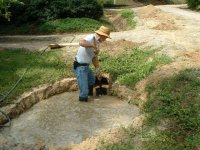I too have had similar situations, and as the others have pointed out proper fall provides the velocity necessary to keep the pipe clear. In your situation rip-rap on the intake side is necessary, regardless whether the pipe is reset or not. Resetting that length of pipe will take some work, hence you may want to try some alternatives prior to taking that step.
Not knowing the configuration and so forth, the idea is to minimize the sediment entering the pipe, and maintaining the velocity. Assuming that you have a long term perspective on the deal, determine the origin of the sediment, then plant ground cover to reduce the erosion, or divert the flow upstream to some other area. (Rosemary is a fantastic for errosion control, drought tolerant, deer resistant, and cheap). I also assume that a 12" culvert is adequate for the flow.
That said let's think about allowing the sediment to pool and settle upstream (in an area that can easily be cleaned) prior to entering the culvert. Much like the baffle in the septic tank allows the solids to settle and the clear water to flow. If a dam could be made with an overflow discharge pipe then we've accomplished this task. A dry-well setup may also be feasible.
For the swale between the discharge pipe and the culvert, consider using a geotextile fabric, aka weed mat. This is great stuff, the water stays on top of fabric, and protects the soil below it. After overlapping the fabric and stapling it down, use a small rock to protect it and it will NOT reduce the velocity of the water. I use 1 1/2" river rock, its large enough that the water won't move it, smooth enough that the water can easily ride on top of it, and easy to work with. You may need larger rock for the sides of the swale.
It's unfortunate that there isn't any water available. What would it take to bring water there, 1000' of garden hose, a temporary basin, ten drums, a water truck, dam it up now and collect the water, portable pumps - I don't know. While compacting a 1/2 mile long trench I used several 1000' rolls of drip tubing, granted the flow wasn't great, however time was on my side and the tubing was later used in the irrigation system.
Assuming that water is brought to the site, I submit the following observations. For each foot of clogged pipe there is .75 cu. ft. of material. A fire engine carries between 500 -1000 gallons, CDF engines are more like 500. A 1" hose flows 40 gpm, 1.75" 100 to 200 gpm. Injecting water on the discharge side will be an extremely muddy affair, and and only so effective. Think about a garden hose stream pointed into the ground, it doesn't take long until the water that's accumulated in the hole, absorbs the energy from the water entering it. For crude horizontal boring I'll strap the nozzle and hose to a pipe or rebar in order for the nozzle to stay in contact with the soil. CDF doesn't have such a contraption, and overall they might be reluctant to subject their equipment to such abuse. The nozzles are expensive, and purchased with tax payers $ - sensitive topic. Another CDF consideration is the travel distance to refill their tank, what if an alarm comes in and their tank is empty?
Approaching the culvert from the intake side is much cleaner, but with it being so clogged any large flow of water will also make a mess. Consequently a slow flow would be in order.
In conclusion, the water availability will determine the approach. If gravity fed, or low psi, then work from the intake side using a long 2x4 or pipe to assist the water. If high pressure water is available then a garden hose attached to a 3/4" copper pipe with a nozzle might be quicker and more effective.
In any event send a PM, I'm interested to know how things turn out.
It appears that CDF provides your fire protection

